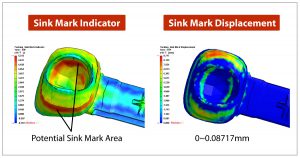Injection molding is a widely used manufacturing process to create complex shapes that require high precision and consistency. However, one of the biggest challenges in injection molding is sink marks. Sink marks occur when there is an uneven distribution of material during the cooling process, resulting in visible depressions on the surface.
This can greatly impact the aesthetics and functionality of a product. We will discuss what sink marks are, their causes, and why it is important to avoid them in injection molding. We will also present techniques and tools that can be used to overcome sink marks, including SolidWorks Plastics, which offers benefits such as predicting potential issues before production and optimizing part design for better results. By understanding how to solve the problem of sink marks, you can ensure high-quality products and satisfied customers.
Understanding Sink Marks in Injection Molding:
Maintaining the surface finish of a molded part is crucial in injection molding. However, uneven cooling or insufficient packing pressure can cause sink marks, which not only affect the appearance but also compromise the structural integrity of a part.
Sink marks tend to form where thick and thin sections of a part meet, or at locations with complex geometries. It is imperative to understand these factors that contribute to sink marks in order to eliminate them from the design and manufacturing process altogether.
The Problem of Sink Marks:
Sink marks are a common problem in injection molding that can occur when the center of a plastic part cools and shrinks faster than its outer surfaces. This uneven cooling causes the material to sink inward, creating visible depressions on the surface of the part. Sink marks can be particularly problematic for parts that require a smooth or polished finish, as they can cause cosmetic defects that compromise the part’s appearance and functionality. To prevent sink marks from occurring, mold designers may adjust their designs to minimize thick sections or use specialized techniques such as gas-assisted injection molding.
Factors Leading to Sink Marks:
When it comes to injection molding, sink marks are a common problem that can impact the overall quality and durability of the product. Sink marks occur due to uneven cooling or insufficient packing pressure, and they can create cosmetic and functional issues in a part.
It’s important to understand that several factors can contribute to the occurrence of sink marks, including part design, material selection, and processing conditions. Addressing these factors through proper mold design, cooling techniques, and material additives can help reduce the appearance of sink marks and improve part stiffness.
Importance of Avoiding Sink Marks:
Avoiding sink marks is crucial to maintain the integrity and appearance of injection molded products. Sink marks can impact critical dimensions and cause structural issues, leading to product failure. In addition, the appearance of sink marks can be unsightly, leading to customer dissatisfaction.
By taking steps to prevent sink marks during the design and manufacturing process, companies can save time and money by avoiding costly rework and ensuring that their products meet the desired quality standards. Proper material selection, design modifications, and process optimization can all play a crucial role in minimizing or eliminating sink marks. Working with an experienced injection molding partner who understands these challenges can help ensure that your product meets your expectations.
Techniques to Overcome Sink Marks in Injection Molding:
When it comes to overcoming sink marks in injection molding, there are several techniques that can be employed. One approach is to increase the packing pressure and holding time to ensure full cavity fill. This can help prevent material shrinkage and reduce the occurrence of sink marks.
Another technique is to adjust the melt temperature and injection speed to reduce viscosity, allowing the material to flow more evenly throughout the mold. Modifying part design by eliminating thick sections or changing the gate location can also help prevent sink marks from forming. For parts with particularly thick sections, gas-assisted injection molding can be used to create a hollow section that reduces the amount of material needed to fill the part.
Finally, post-molding techniques such as sanding or painting can be used to conceal any remaining sink marks and improve the final appearance of the product. With these techniques and others at their disposal, manufacturers can overcome sink marks and produce high-quality injection molded products that meet their customers’ needs.
Avoiding Sink Marks with SolidWorks Plastics:
SolidWorks Plastics simulation software offers a revolutionary solution to the problem of sink marks in injection molding. By providing a virtual prototype of the desired product, SolidWorks Plastics enables manufacturers to identify potential defects early on and make necessary adjustments to avoid costly mistakes during production. This software allows for adjusting the gate location and size, as well as wall thickness, which can all contribute to preventing sink marks.
Furthermore, using textured surfaces or ribs can help distribute material evenly and reduce the likelihood of sink marks, enhancing product quality while reducing waste. Proper cooling time and pressure are also essential factors that can be effectively simulated through this software. Overall, SolidWorks Plastics offers an innovative and cost-effective method for avoiding sink marks in injection molding.
Benefits of SolidWorks Plastics in Injection Molding:
SolidWorks Plastics is a powerful tool that brings many benefits to injection molding projects, especially when it comes to avoiding sink marks. One of its main advantages is the ability to identify and fix potential issues before production begins, saving time and resources in the long run. By experimenting with different materials, gate locations, cooling strategies, and other variables, engineers can optimize their designs for maximum performance and minimum defects.
In addition to predicting sink marks, SolidWorks Plastics provides detailed simulations of how the material will flow through the mold, allowing designers to make informed decisions about wall thickness, rib placement, and other critical factors. This not only reduces the risk of sink marks but also improves part quality overall. With its intuitive interface and robust feature set, SolidWorks Plastics is an indispensable tool for any injection molding project that values efficiency, accuracy, and excellence.
 Plastic Injection Mold Material Guide – Advantages & Applications Of 20 Common Injection Molding Materials
Plastic Injection Mold Material Guide – Advantages & Applications Of 20 Common Injection Molding Materials  10 Plastic Injection Processes – Advantages, Disadvantages, And Applications Of Plastic Injection
10 Plastic Injection Processes – Advantages, Disadvantages, And Applications Of Plastic Injection  Understanding the Sink Marks in Injection Molding | Causes and Solutions
Understanding the Sink Marks in Injection Molding | Causes and Solutions  Solving the problem of injection molding sink marks
Solving the problem of injection molding sink marks